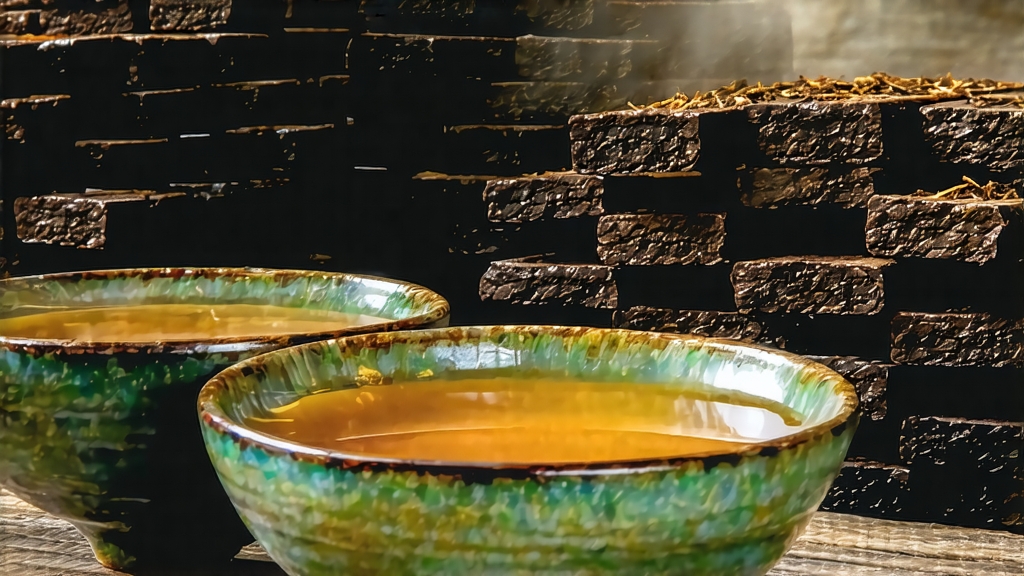
Liu Bao, literally “Six Forts,” is the name of a once-secret black tea that has been quietly mellowing in the karst mountains of southern China for five centuries. To most Western drinkers “dark tea” begins and ends with Yunnan’s Pu-erh, yet Liu Bao is older than many Pu-erh recipes, and its flavor profile—think black-forest honey, camphor, and a faint echo of betel nut—offers a gentler gateway into the world of post-fermented teas. This article tells the complete story: from Ming-dynasty horse caravans to the microbial alchemy that happens inside a bamboo basket, and finally to the quiet ritual of brewing a tea whose leaves have already traveled through time.
-
Historical footprints
The earliest written record appears in the 1580 edition of the Guangxi Provincial Gazetteer: “Tea from Liu Bao, exchanged with the Yao for salt and horses.” The tea left the township on bamboo rafts, drifted down the Liu River to the Pearl River, and reached the port of Guangzhou just as European galleons were anchoring. By the late Qing the British East India Company listed “Loong Pao” (a corruption of Liu Bao) alongside Lapsang Souchong in their Canton ledgers, praising its “deep liquor suited to long sea voyages.” When the Opium Wars rerouted trade, Liu Bao retreated inland, becoming the staple of Hakka mountain villages and a medicinal beverage for miners working the Guangxi tin belts. Only in 2008 did the China National Tea Museum officially re-classify it as a protected geographical indication, sparking a renaissance that now sees small batches air-freighted to Berlin, Melbourne, and San Francisco. -
Terroir and leaf
The core micro-region is a 15-km radius around the town of Liupao in Wuzhou Prefecture, where red lateritic soil, humidity above 80 %, and warm winters create a natural incubator for fermentation microbes. The cultivar is a large-leaf landrace called Zhongye (“medium leaf”) that sits genetically between Yunnan’s Assamica and the small-leaf Fujian types. Farmers pick one bud plus the third or fourth leaf—mature, waxy, and rich in pectin—because these older leaves withstand the forthcoming wet-pile without collapsing into compost. -
Craft: the double fermentation
Liu Bao is the only Chinese tea that undergoes two distinct fermentations separated by years.
Stage 1 – Primary kill-green and pile-fermentation
After a brief outdoor withering the leaves are pan-fired at 280 °C for eight minutes, hot enough to blister the skin yet short enough to preserve leaf integrity. While still warm they are piled 70 cm deep inside cedar-lined chambers. Workers spray a fine mist of the local mountain water (pH 6.2, naturally laced with lactobacillus) and cover the heap with jute sacks. For the next 25 days the pile is turned every 48 hours; internal temperature climbs to 55 °C, initiating a microbial succession dominated by Aspergillus niger, Blastobotrys adeninivorans, and a unique yeast dubbed Wuzhouensis CL01. The leaf color shifts from olive to umber, and the first notes of dried longan appear.
Stage 2 – Bamboo-basket aging
The half-fermented maocha is steamed soft, then packed by hand into cylindrical bamboo baskets lined with wild banana leaf. Each basket holds exactly 37 kg, a weight that allows micro-oxygenation without anaerobic rot. These towers are stored in riverside caves where year-round humidity hovers at 85 % and temperature cycles between 18 °C and 24 °C. Here the tea rests for a minimum of three years; premium labels see fifteen, twenty, even fifty. Over time the second fermentation slowly oxidizes residual catechins, converting them into theaflavins and theabrownins that give Liu Bao its trademark ruby-black liquor and silky mouthfeel.
- Grades and tasting lexicon
The industry shorthand is “Three Numbers”: 1st grade (one bud, two leaves) for boutique cakes, 3rd grade for daily drinkers, 5th grade for dim-sum restaurants. Aged examples are coded by basket year—e.g., “90LB” means 1990